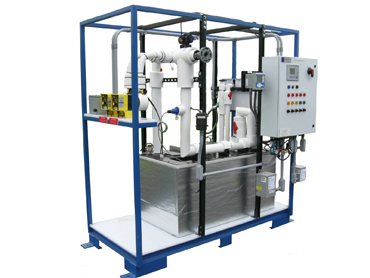Client: Hazardous Waste Management company providing cradle to grave solutions for the local industry.
Location: Greensboro, NC.
Industry: Hazardous Waste Management.
Installation Date: February 2012.
Objective: To safely neutralize concentrated waste acids and waste alkalis collected from local industrial generators. Influent flow can vary from 300 GPD to over 3,000 GPD with organic and inorganic acids and alkalis, concentrations ranging up to 20% including battery acid.
Overview: A hazardous waste management service provider collects spent chemicals from local industry. Many of these chemicals can be treated locally to render a totally harmless byproduct. This includes a variety of acids and bases as well as oxidizing and reducing agents.
It is the desire to neutralize as much of the waste acid with the waste base so as to minimize the amount of acid and base that must be purchased for the purpose of neutralization and we are able to provide this safely.
Since the concentration and makeup of the waste acids and bases are unknown they are kept separate with collection for inorganic acids, organic acids, and all alkalis. Most of the waste products are stored in and pumped from 55 gallon drums. The waste concentrates are metered in slowly to the process while temperature is closely monitored.
The entire system is located outdoors, as such it is provided with UV protection and freeze protection via heat tracing and insulation.
The Process: Digital Analysis Corp. has developed a unique process for safely mixing waste acids and bases by very closely monitoring temperature and reaction rates. The rate that the waste acids and bases mix is controlled so as to limit or prevent adverse reactions and excessive liberation of heat.
Solution: Our pHASE wastewater treatment skids are very versatile, modular, and flexible. In this application our pH10 served as the heart of the treatment system which consisted of several totally automated stages aslisted below:
- Influent Equalization
- Waste inorganic acid collection
- Waste organic acid collection
- Waste alkali collection
- Batch pH adjustment based upon our pHASE pH10.
- Temperature monitoring and water quench
- Final Effluent Monitoring.
- Remote monitoring, control, and data logging
- Double containment
- Freeze and UV protection for installation outdoors.
Conclusion: The key design consideration for this system was not only effluent compliance but safety. Concentrated spent chemistry is actively neutralized using, in most cases, spent chemistry. Adverse reactions are known to occur and must be controlled. Furthermore this system is installed in a location that does see frequent traffic.
The system was designed to maximize the use of spent alkalis to neutralize spent acids. This requires that we constantly monitor the rates of reaction and the temperature of the process. Chemical metering is controlled by many parameters including temperature rise. In the event of an uncontrolled temperature rise a water flush circuit is available to rapidly add cooling water, although, by design, this should never happen.

The system described here is based upon our pHASE pH10 but modified specifically for this application. In addition to the safety features of the process the system is designed to be installed outdoors in a contained area. As such the system is provided with UV protection and freeze protection via heat tracing and insulation.
A remote monitoring system is installed that monitors the entire system from anywhere in the world where an Internet connection is available. All of the programmable parameters, tuning variables, and setpoints are available through the remote monitoring system.
For additional information or to inquire about a our systems send us an email at mailto:[email protected] or call us (at the numbers below)

